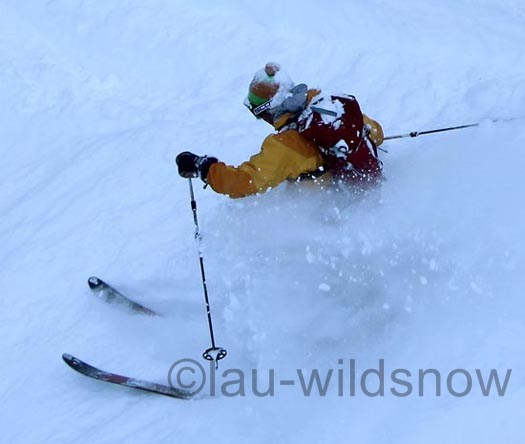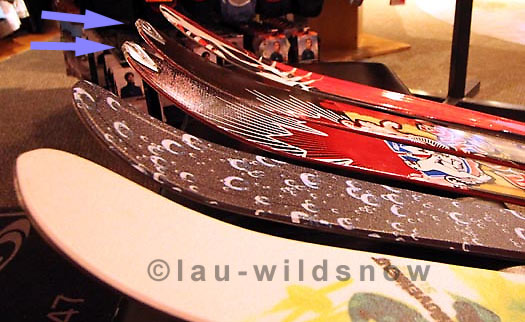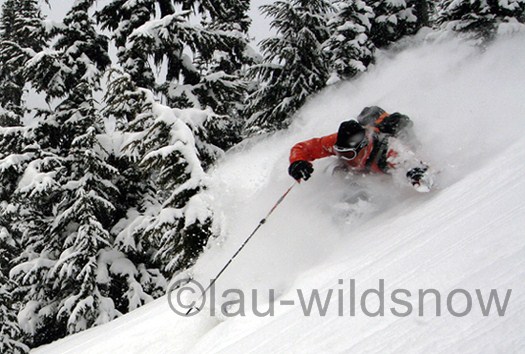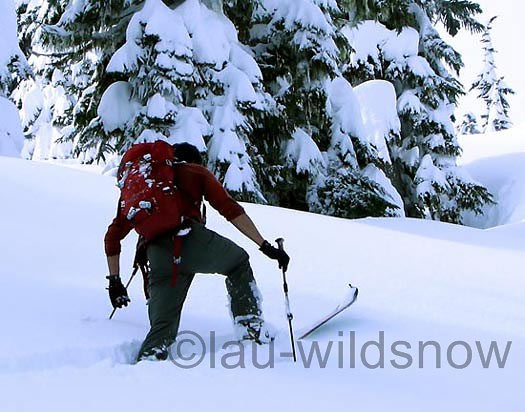Words and photos by Sharon Bader and Lee Lau unless otherwise noted.
It hasn’t escaped notice that Dynafit has made forays into the big boot market. The Titan and ZZeus in particular drew this reviewer’s praise for being best in class in marrying tourability with stiffness. What’s been missing is a fat ski. In my (admittedly initial impressions) review I was lukewarm on the Manaslu. At 95mm underfoot it was “merely” a mid-fat underfoot, a bit one-dimensional (best for powder) and felt fragile. Anecdotal evidence from other users supported my impressions. Dynafit’s lack of; (i) wide ski crampons, (ii) wide ski brakes; and (iii) a fat ski was somewhat indicative of lackadaisical product development in the PHAT ski and bindings market.

Dynafit Stoke is a competent powder performer for backcountry skiing.
Enter the Stoke ski. Greg Hill, a local Revelstoke touring machine (former ski bum – now somewhat of a celebrity in ski-touring/mountaineering) has been a Dynafit athlete for quite some time. Revelstoke has a big, deep snowpack. Greg tours a lot. Like those of us who live in the Coast Mountains of Canada, his snowpack allows him to ski big lines throughout the snow season. Greg Hill has a use for a fat, relatively tough ski which can tour well and had a hand in designing Dynafit’s new offering. I spoke to Greg and the good folks at Salewa to get a handle on the Stoke.

Stoke ski (indicated by arrows) has an 'early rise' shovel compared against traditional skis.
I was loaned a pair of Stoke skis with Dynafit FT10 bindings for three days. I am not sponsored by Dynafit but have a good working relationship with Salewa (the Dynafit North American distributor) having reviewed a lot of their equipment. I skied one day at Blackcomb mountain in the middle of a large wind and storm event – mainly on softpacked snow. I toured on the skis over a two day period. The first day involved heavy trail breaking (1800m elevation gain) to a sub-alpine treed zone with 80cms new snow. On the second day I returned to that same zone alternating using my old skintrack and also breaking trail to new areas.
I’ve discussed the conditions in which I’ve tested these skis to give you, the reader, some context for the review. I’ve seen a growing trend where reviewers have skied powder-oriented gear on barley dusted resort groomers or hardpack conditions. I can’t see much value in writing such bird-cage lining filler. If it’s a backcountry powder ski, go ski it in backcountry powder. So I did.
PERSONAL BIASES
I weigh 155 lbs and ski mainly in the Coast Mountains of British Columbia in the Vancouver/Whistler/Squamish area. I often travel to the Selkirks, the Monashees and to other touring destinations in B.C. However, my skiing is usually in fairly high moisture-content snow. Accordingly, my preference is for bigger skis and boots. I ski about a 100 days a season. About 70% of my skiing involves some touring.
As for equipment, I skied the Stokes with Garmont Megarides (with Intuition ProTour liners) ie a fairly soft four-buckle boot and with Dynafit ZZeus’s with Intuition PowerWrap liners – ie a fairly stiff setup. I won’t comment specifically in this review on comparisons between the Stoke ski and other skis; you can ask me about comparisons in the article comments (I’ve owned or skied a lot of the Movement, Black Diamond and Atomic touring ski offerings ranging from skinny to fat) so fire away with questions.
My test skis, verified specifications and added info:
– 182 cms length
– 1640g (Dynafit’s catalog shows weights at 1645g (+/- 30g) – this compares favorably with common ski weights and is quite light for this plank’s width and length.
– Shovel, waist, tail at 130-106-120 with a 32m sidecut turning radius
– The graphics were designed in Europe (that maple leaf and the olde English graphics can be blamed on non-Canucks).
– The sidewalls have been reinforced to be more beefy so should be more rock-resistant.
– The edges are definitely thicker than the Manaslu’s paper-thin efforts (note that one reason Manaslu is so light is the minimalist edges).
– That is a snow leopard on the top-sheet; not a lion rampant.
– Stoke will come in 164, 173 and the tested 182 cms lengths (dimensions may differ slightly – eg 129-105-119 in 173cm). A bit strange to forego the longer lengths – it skis short with the early rise tip; the 182 is perfect for me and I’m not big. Bigger dudes will have to wait till next season when a 191cm long Stoke will be produced.
– That is supposed to be some sort of coniferous plant in the heraldic shield – it is NOT a pot plant. The heraldic shield is not the City of Revelstoke’s crest.
– The Stoke isn’t rockered. It has an early rise tip, a bit more so then the Manaslu (see picture above to compare against traditional skis). Stoke has a 25cm shovel, Manaslu has a 23cm shove and a BD Verdict (traditional ski (a 19 cm shovel). This early rise tip is supposed to aid in skiing powder.
– Stoke has a slightly upturned tail with rubber grip and a cut out for skin tail attachments. Note this is a far cry from a twin tip. This is meant to aid in tight situations (anchor for jump turns); it’s also good when you’re using the ski as a picket and nice when you’re skinning up steep tracks.
– The Stoke’s wood core (bamboo and paulownia – look it up, I had to) is laid up on edge. This core and the ski’s general design allowed Dynafit to achieve what Greg wanted; stiff underfoot but a bit softer tip and tail – hopefully allowing the Stoke to shine in variable conditions.
– Dynafit has no plans for brass mounting inserts for the heel piece in the Stoke at this time. The inserts are one-time use (or a few times if you are careful). I skied the ski as it was given to me with the binders mounted at the marked mid-point. Greg mounts the bindings on the forward mounting position. I don’t know how the inserts will hold up over time but since this is a big ski already I personally would have traded a bit more ski weight for the stronger brass mounting inserts — not just so binders can be mounted multiple times but for what I believe would be an extra strong binding mount.
That being said, it’s understandable that Dynafit has stayed away from using brass as doing so would require them to provide the proper machine screws to fit the Dynafit, and binding centering could perhaps be an issue due to the different type of fastener. As has been mentioned elsewhere here on WildSnow, if you do use Dynafit ski inserts for a binding mount, install the screws with a dab of epoxy and be careful not to over tighten (gently heat screws with soldering iron to reverse).
ON-SNOW PERFORMANCE
Stoke is a competent uphill ski. It won’t propel you up slope 10,000 feet per day by itself despite its namesake. There’s nothing revolutionary about the Stoke from a touring perspective; the early-rise tip doesn’t help much in heavy snow trail-breaking unlike a rockered tip ski like the Megawatt which made easy work of 65 new cm of dense snow. In itself this isn’t all that surprising. The Stoke is light for a big ski (note the emphasis), but it is still a 106 underfoot ski: Lots of skin underfoot to drag around and it has definitely got heft compared to something like a Manaslu.
I approve of the slight upturned tail. It helps when you’re sawing back and forth in steeps or when you’re trying to get through any particularly tight spots. But there’s enough to work with that on kick turns you can dig that tail in to help prevent sliding back. Of particular note is the rubberized grippy material on the tail with the skin tab cutout, which goes a long way to keeping skins on the ski. Yet the tail isn’t so flipped that it prevents the ski from being used as a picket — useful when climbing.
Invariably someone will ask about the Stoke’s performance on groomers so I might as well get that over with despite my initial “who cares” reaction. It’s a competent ski in hardpack — not exciting – not quick but it will hold an edge. Stoke is decently stable on hardpack.
A relevant question from a touring perspective will be the Stoke’s edge-hold ability (spring corn, icy steeps, icy sidehills, couloirs). Frankly I don’t know as I only skied it in deep powder. I would imagine that the ski is adequate in those situations given that it’s stiff underfoot, but that’s just speculation.
Enough about hardpack. Stoke is a born and bred powder ski. It charged, ripped, slayed (I could go on but I’ll spare you) powder. It ripped through pillows. I sailed off 15 footers, 20 footers to minimal transitions and landed. It’s confidence-inspiring in medium turns and long radius turns in powder. If you used some body-english (yes I mean bum-wiggle) you can also work short-radius powder turns. Where you really have to work the Stoke is in short radius or sharp quick turns in variable snow. I encountered this at the lower elevation ski-out and you have to work and concentrate hard to get the Stokes swinging around.
A word on the boot-ski pairings. I think the Stoke can be skied by lighter skiers or finesse skiers in powder with lighter boots. I had them on my Garmont Megarides on the first-day in the resort and it felt fine. However, the Stoke feels better driven hard. It really came alive when paired with my relatively stiffer Dynafit ZZeus boots.
CONCLUSION
Ask yourself honest questions: Do I ski a lot of steep pow? Do I charge big lines? If you do and you earn your turns, then this is the plank for you.
Although the Stoke was designed by a guy whose local terrain has lots of perfect deep and steep, due mostly to its flex this ski is versatile enough to deal with dicey, sub-optimal snow as well. The only place where it may not be a good performer is in tight turns (exiting bushy terrain for example) or on ice, but then, not much makes that stuff pleasurable.
Having said that, this is not a ski for the lazy skier or for skiers with poor technique. Stoke rewards a firm hand at the wheel. If you want something forgiving of tired legs or of endemic snowplows, look elsewhere.
(WildSnow guest blogger Lee Lau is an avid skier and outdoorsman embarking on many adventures with his loving, and sometimes concerned wife, Sharon. He has over 15 years of experience skiing, ski-touring and dabbles in mountaineering. In the “off-season” he is occasionally found working in his day job as an intellectual property lawyer when he is not mountain biking. As a resident of Vancouver, British Columbia, Lee’s playground extends mainly to Western Canada, including South West B.C. and the Selkirks.)
Guest blogger Lee Lau is an avid skier and outdoorsman embarking on many adventures with his loving, and sometimes concerned wife, Sharon. He has over 15 years of experience skiing, ski-touring and dabbles in mountaineering. In the “off-season” he is occasionally found working in his day job as an intellectual property lawyer when he is not mountain biking. As a resident of Vancouver, British Columbia, Lee’s playground extends mainly to Western Canada, including South West B.C. and the Selkirks.


